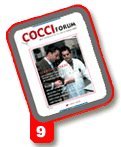COCCI People: GroundbreakersVeterinarian Walter T. Johnson laid the foundation for coccidiosis vaccination
It was 50 years ago that Dr. Alan Edgar introduced the first commercial vaccine for controlling coccidiosis in poultry. Today, vaccination is known to be a reliable and practical means of immunizing birds against the Eimeria parasites that cause the disease. Less widely known is that about 30 years earlier, Dr. Walter T. Johnson, a veterinarian, laid the foundation for modern understanding of immunity and vaccination. Johnson was a pioneer in coccidiosis research. His work has been largely neglected, probably because many of his findings were published in agricultural experiment station bulletins and reports instead of in peer-reviewed journals. Johnson was born in Minnesota in 1892 but at an early age moved to Washington State. He was raised on a
farm and worked as a farm hand with general livestock. He studied veterinary medicine at Washington State College
in Spokane and, after graduating, was an instructor in veterinary medicine. During this period, he published many articles on topics ranging from poultry diseases to pathological conditions in
cattle. Introduced new concepts
A new journal, Poultry Science, invited Johnson to write about coccidiosis. Kept pure Eimeria stockToday, few laboratories in the world can claim to keep pure stocks of the seven widely known species of Eimeria. Johnson, however, maintained six species: E. acervulina, E. mitis, E. maxima, E. tenella, E. necatrix and E. praecox. During the early years of the twentieth century, it was generally thought that only one species existed, but, by 1927, his contemporary Ernest Tyzzer had recognized two species, E. avium and E. tenella and in 1932 described E. acervulina, E. mitis and E. maxima. In 1930, Johnson described two further species, the highly pathogenic E. necatrix and a species with little pathogenicity, E. praecox.
In 1927, Johnson’s work involving immunity was published in Poultry Science. He described several important principles for the first time, including the absence of cross protection between species, establishing the theory that several species are required to adequately vaccinate birds. It was Johnson’s experimentation with immunization that demonstrated vaccination might be of practical use. He inoculated birds with gradually increasing numbers of oocysts and found that small doses resulted in “very high resistance.” Experimental field immunizationIn a 1928 bulletin, Johnson reported that field tests were already supporting his experimental conclusions. He tried incorporating oocysts into feed, and “the results lend encouragement to feeding sporulated oocysts in wet mash as a practical means of immunization.” This work occupied the later years of his life.
His own words, published in 1933 and 1938 bulletins, best describe his work at the time: “Considerable progress has been made, and it is
hoped that this means of control will be perfected and generally used.… The viewpoint that actual inoculation of young stock on poultry farms act as a control measure is becoming more valid as the facts regarding coccidiosis are ascertained. Nature’s method seems
to leave too much to chance to prove satisfactory. The recommendation to purposely infect by actually feeding
oocysts involves a rather complicated procedure. The multiplicity of species certainly complicates the solution,” Historical photos and illustration courtesy
of Agricultural Experiment Station,
Corvallis, Oregon. |








 © 2000 - 2021. Global Ag MediaNinguna parte de este sitio puede ser reproducida sin previa autorización.
© 2000 - 2021. Global Ag MediaNinguna parte de este sitio puede ser reproducida sin previa autorización.